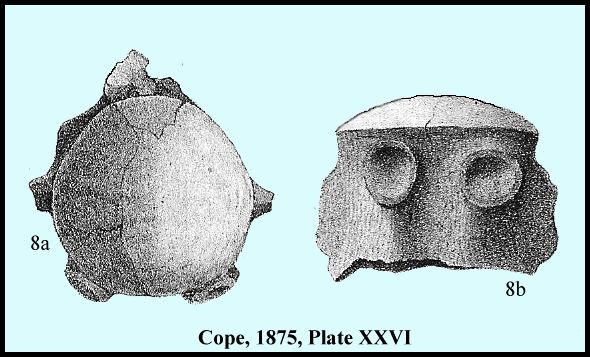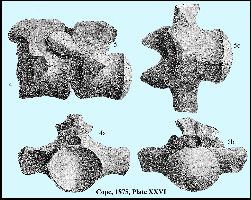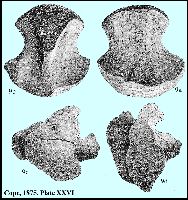The specimen was mentioned briefly
by Merriam (1894, p. 31) who indicated that it is from the "Niobrara of
Colorado."
Merriam, J. C. 1894. Ueber die Pythonomorphen der
Kansas-Kreide. Palaeontographica 41: 1- 39, 4 pls.
Williston (1898, p. 180) was the
next to comment on the specimen, reporting it as Platecarpus
crassartus, but disagreeing with Cope about the identification. Williston
believed it was more likely something like Prognathosaurus [Prognathodon] Dollo.
He also noted that it "evidently has strong relationships with Brachysaurus,
and I would have referred it to that genus save for the free chevrons [on the caudal
vertebrae]." As it turns out, he was right to be concerned, but it would take 90 more
years for someone to notice.
Williston's Brachysaurus was
later found to be pre-occupied by Hallowell, 1856, and Williston's B. overtoni
(1897) from the Pierre Shale of South Dakota was eventually referred to Prognathodon Dollo
1889. Prognathodon means "forward jaw tooth," describing the way that the
anteriormost teeth extend forward beyond the end of the jaws.
Although Williston (1898) repeated Cope's locality as
"Eagle Tail, in Colorado," he said that he had visited the place where the
specimen was collected with Professor Mudge. He stated that it was definitely "within
the borders of Kansas," and it was clearly from in the Fort Pierre (Shale). However,
since that time, the locality has remained somewhat of a mystery. Williston (1898, Plate XLV) figured a
vertebrae, humerus and an unidentified paddle bone.
Williston, S. W. 1898. Mosasaurs. The University
Geological Survey of Kansas, 4(5): 81-347, pls. 10-72.
Lane (1946, p. 315-316) noted that Platecarpus
crassartus was from the Fort Pierre of "extreme western Kansas" and
essentially repeated Williston's remarks.
Lane, H. H. 1946. A survey of the fossil vertebrates of
Kansas, Part III, The Reptiles. Kansas Academy Science, Transactions 49(3): 289-332, 7
figs.
Russell (1967, p.
164) was the next to comment on the specimen and formally referred the specimen to Prognathodon
crassartus, noting that it came from the "Pierre Formation near Eagle Tail,
Kansas." He also noted that only five vertebrae of the type could be located.
Russell, D. A. 1967. Systematics and morphology of
American mosasaurs. Peabody Museum of Natural History, Yale University, Bulletin 23.
This might have
been a good place to end the story, but some issues in paleontology are never really
settled. In their paper on Prognathodon, Lingham-Soliar and Nolf (1989, p. 171)
noted that the vertebrae and the humerus of the specimen found by Mudge are very similar
to those of European specimens of Plioplatecarpus, and added that ""Prognathodon"
crassartus seems to be clearly referable to Plioplatecarpus."
In addition, Bell (1993, p. 20) wrote "... Prognathodon crassartus (=
Plioplatecarpus indet., see also Lingham-Soliar and Nolf, 1989: 171)."
While it is quite
likely that they are correct, neither paper referred to the specimen by number (AMNH FR
1562) or indicated that the actual remains had been examined. In comparing the
humerus, Lingham-Soliar and Nolf, it seems clear that they were using the drawings
provided by Cope (1875) since Russell (1967) noted that the humerus was no longer present
in the specimen.
Everhart and
Bussen (2001) reported the first remains of Plioplatecarpus
cf. primaevus from the upper Sharon Springs Member of the Pierre Shale, near
McAllaster, in western Logan County, Kansas. According to Pete Bussen (pers. comm, 2005),
this is the same stratigraphic level as the exposures south of Sharon Springs that
probably produced the remains found by Mudge in 1870. The specimen consisted of most of
the skull, one cervical and several dorsal vertebrae and some ribs. Interestingly, the
ribs were noted to be round in cross-section, a feature typical of Plioplatecarpus,
and also reported by Cope (1875, p. 154).
The current
(February, 2005) records of AMNH FR 1562 note the locality as "Eagletail,
CO near but in KS." The record also notes that the specimen consists of "6
vertebrae: 2 dorsals, 1 pygal & 3 caudals. Parts of type missing."
I looked in Google for a reference to
Eagle Tail, Kansas or Colorado… and found that:
“When the Kansas Pacific Railroad was being built
through Kansas, a stop was made nine miles west of the City of Wallace. A few buildings
were erected there and a town called Eagle Tail was
established in December 1869, named after an ancient Indian watering place. These springs
were said to provide a never-failing source of water, something not always available in
western Kansas. In 1886 the name was changed to Sharon Springs after Sharon
Springs, New York, a spa located about 40 miles west of Albany,
New York.”
Sharon Springs is about 10 miles west of old “Fort
Wallace”, sitting on the Union Pacific Railroad, and is right in the middle of the
Pierre Shale in Wallace County, Kansas. The specimen probably came from canyons in the
Pierre Shale south of the town. According to Peterson (1987), Mudge
was collecting in the vicinity of Fort Wallace during the summer of 1870 and would have
referred to the town as Eagle Tail when he collected the specimen. Mudge probably sent the
material to Cope later that same year. It’s just a
small bit of data but it does put Prognathodon
in the lower-middle Campanian in Kansas. As far as I know, it’s the only record.
Peterson, J. M. 1987. Science
in Kansas: The early years, 1804-1875. Kansas History Magazine 10(3): 201-240.
There you have it.... Liodon to Platecarpus to Prognathodon
crassartus to ???...... it only took 130 or so years
M. J. Everhart |



